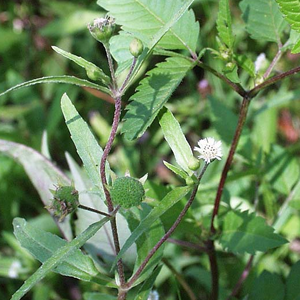False Daisy Ayurvedic And Medicinal Properties

False Daisy
Honeybees are lovely insects which drink nectar from thousands of flowers and convert it into honey in its beautifully built beehive.
Honeybees are generally categorized as a beneficial insect is on the verge of total extinction due to climatic changes and other external perils. The main reason of dwindling is due to the usage of dangerous pesticides and fertilizers.
The chemical named neonicotinoids are spreading death to honeybees in the country of USA and the world. If the same trend continues there will not be any bees in the world.
This topic will deal with a plant named False daisy which comes under sunflower family. The botanical name of this plant is Eclipta prostrate.
No slides are available in this gallery
The other common names of this plant are yerba de tago and bhringraj, Karisalankanni, and bhringraj,
How its Grown And Cultivated
- This plant finds a place in Ayurvedic text.
- This plant is found abundantly in most parts of the world and very famous in India, especially in South India.
- In Tamil Nadu it is called as karisilanganni and in Kerala it is called as kayyunni.
- False daisy has cylindrical and grayish roots with solitary flower which measures 6-8 mm in diameter with white florets.
- It is found abundantly in India, China, Thailand and Brazil.
- In north India the people call this plant as bhangra, bhringaraj, bhrungraja and bhringraja.
- False daisy is commonly found in waste lands and other unused places.
- The Stems are erect or prostate and entirely velvety.
- The oblong lanceshaped leaves measures 2.5-7.5 cm long.
- False daisy is an annual growing plant which reaches a height of 2 ft. It flowers during the month of August.
- The flowers have both male and female organs. It grows well in sandy, medium and heavy soils.
- It prefers moist or wet soil and grows in semi-shade.
False Daisy Ayurvedic Properties
- Ayurvedic physicians use this plant for various purposes.
- It has bitter and dry taste.
- This herb supports hair growth and it is used as an ingredient in Ayurvedic hair oil.
- Bhringaraja when translated in English will give out a meaning ‘King of Hair’.
- This oil promotes hair growth and color.
- As per ayurvedic system this plant improves the digestion and improves the functions of the organs.
- False Daisy contains coumestans such as wedelolactone and demethyl wedelolactone, polypeptides, polyacetylenes, thiophene derivatives, steroids, triterpenes and flavonoids.
Medicinal Properties
- These flowers are classified as one of the “Ten Auspicious Flowers” in Hindu mythology.
- The decoction is used in uterine hemorrhage.
- The juice of the plant mixed with honey and castor oil is given to the infants for expulsion of worms.
- It also has anti-inflammatory properties and the leaves may be applied to insect bites, stings, swelling and other skin diseases.
- The plant is used as antiseptic, astringent, depurative, emetic, febrifuge, ophthalmic, purgative, styptic and tonic.
- This plant also finds a place in traditional Chinese herbal medicine.
- It is astringent, deobstruent, depurative, emetic, febrifuge, ophthalmic, purgative, styptic and tonic.
- The oil can be applied to athlete’s foot, eczema, dermatitis and wounds.
(Visited 1,869 times, 1 visits today)
